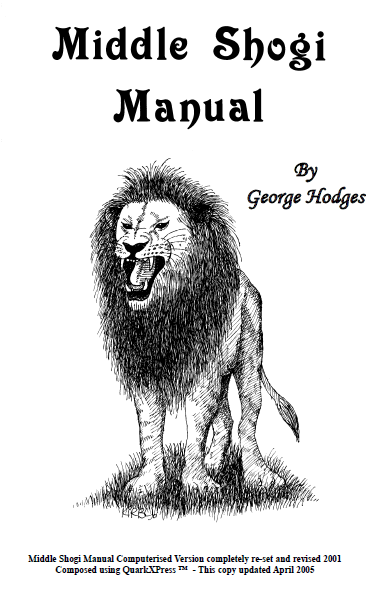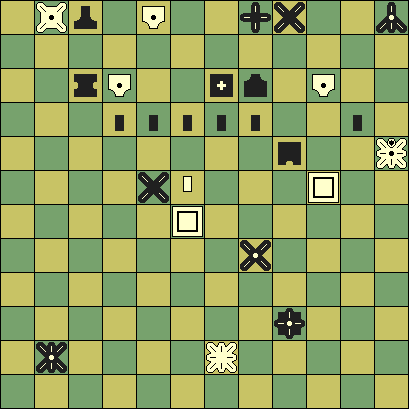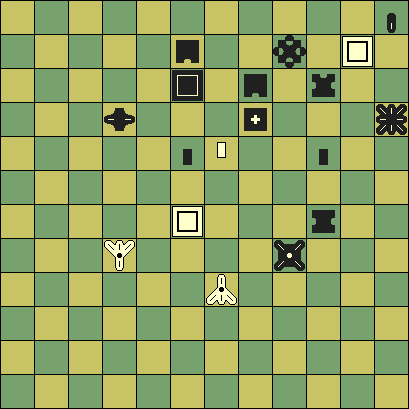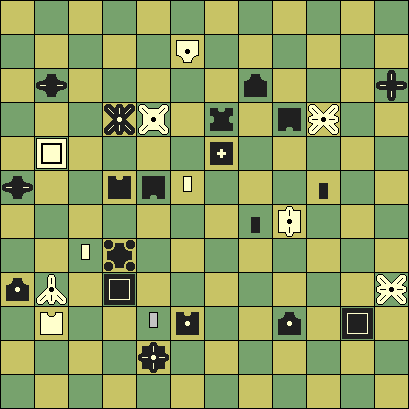
|
The Middle Shogi Manual was compiled by the late George Hodges
from historic Japanese material on Chu Shogi, and contains
224 mating problems from the Edo period.
It is still for sale, in printed form or on CD-ROM, from:
george.hodges@talk21.com
This website lists some new insights into these problems
and their solutions, obtained through analysis with the
Chu-Sogi computer program 'HaChu'.
|
Mating problems, B1-B50
Errata to the Middle Shogi Manual
All problems were fed to the HaChu engine.
This was running in tsume mode with the 'Allow repeats' setting,
which puts the obligation to deviate always on the checking side.
The 'Promote on entry' setting was switched off,
which means that HaChu plays according to the rule that a piece that deferred promotion
can promote on later moves that touch the zone,
but not on the turn immediately following their deferral
(unless they capture).
Note that this is different from what the Middle Shogi Manual states,
where the condition is that the next move with that piece cannot be a promotion
if it isn't a capture.
Below the cases are discussed where HaChu's analysis disagrees
with solutions or comments in the MSM.
The issues can consider minor typos,
a somewhat faster line,
but also complete refutation of a given solution,
and spectacular new solutions.
B5 - The given solution is poor defense; with
2... K-5c 3. DHx4d+ Kx4d 4. FKx2b K-5c 5. FK-3c K-6b 6. FK-4d K-6a 7.+DH-2e G-5b 8. FK-4a K-6b 9. +DHx5b K-7c 10. +DH-7d K-8b 11. +DH-8d K-9b 12. FK-9f K-8a 13. +DH-4a K-9b 14. +DHx10a K-9c 15. FK-9d mate gote can hold out much longer.
B7 - The given solution is correct, but there are several ways to finish the mate quicker:
15. +SM-7c K-5f 16. +SM-4f Kx4g 17. +SM-2g Kx4f 18. +VM-6d K-5f 19. +SM-6g mate
or
17. +SM4e-6c K-4b 18. +VM-6d BT-5c 19. +VMx5c K-4c 20. +SM-6a mate
B8 - The mentioned variation, 2... Kx6c is actually beter defense, as the Lion mate takes one move longer.
B9 - For this problem the exact promotion rule is important. When promotions are allowed on stepping out of the zone, (possibly after a delay of a turn) 2. FL-10d+ is one move faster than the given solution:
2... S9-c 3. +FLx9c BT-8b 4. +FLx8b K-6a 5. FK-1f Rx1f 6. +FL-5b Gx5b 7. +DK-4a G-5a 8. +L-2e DKx2e 9. Ln-5b Phx5b 10. DK-4c mate
Compared to this the given solution inserts the extra moves 2. +DH-10d FLx10d to lure gote's FL to 10d, so sente's FL can leave the zone with a capture. These moves are a pointless delay when promotion had also been allowed when leaving the zone on a non-capture. So it seems that at least the person providing the solution assumes the latter is not allowed. The +DH on 7g is still needed in any case (or 2. FL-10d+ would be refuted by 2... FLx10d), so it gives no clue as to what rule the composer used.
B11 - The 'correct' solution can be improved to a mate in 10 through
5. +DK-7c K-9b 6. +P-8b K-10a 7. +DK7cx7a K-11b 8. +DK+12a K-11c 9. +DH-12d K-11a 10. +DK1a-12a mate
9. +DK-11a K-12c 10. +DK1a-10a mate
B12 - The solution is flawed, because 3... K-6b,
presented as a sub-optimal defense, is actually a refutation.
The given variation does not end in mate,
as the checking +DH supposed to deliver it can be taken by the +R at 4d.
The first move of the given solution already spoils the mate.
It is essential to leave the BT on 4e,
to prevent the +R from capturing on 4d.

The correct solution thus is:
1. +Ky-4d Gx4d 2. FKx6d Kx6d 3. Lnx8f K-5e 4. +DH-3g +R4f 5. +DHx4f Kx4f 6. Ln-6h K-3f 7. Lnx5h-4h K-2e 8. Ln-4f K-1d 9. Lnx4e-3f K-1c 10. Ln-1e K-1b 11. Lnx2e K-2a 12. Ln-4b K-1b 13. Lnx4a-3b
The sub-optimal defense 1... BTx4d then continues like the given solution,
for mate in 12:
1... BTx4d 2. Ln-6e Px6e 3. +DHx6e K-6b 4. +DH-7e +R-6j 5. FKx6j B-6h 6. FKx6h +FL-6g 7. FKx6g +VM-6f 8. +DHx8d K-6a 9. +DH-8c K-6b 10. +DH-8b K-6c 11. FKx6f G-6d 12 FKx6f mate,
which is faster despite of a number of 'futile interpositions'.
(While 3... K-7c continues as the given solution, also for mate in 12.)
B13 - After 7. +DH-6c it is a mate in 12 rather than 17:
7... K-3a (7... K-5a 8. FK-5c +DHx5c 9. +DHx5c K-4a 10. +L-4c mate) 8. FK-3f K-2a 9. +DH-2c FLx2c 10. +Lx2c +DH-2b 11. FK-3b K-1a 12. FKx2b mate
Why ever defer promotion of a Pawn?
B15 - The given line is flawed, as after 3... K-5b there is no mate.
But when we play 3. P-6f= in stead of P-6f+ it works!

At first glance having a Tokin should always be better than having the Pawn,
as the Tokin's moves include the Pawn move.
But there is one thing a Pawn can do that a Tokin cannot:
stand between two Lions without forming a 'capture bridge' between them!
So the move 4. Ln-5d which saves the day after 3... K-5b
cannot be refuted by 4... Lnx6dx5d when 6d is a Pawn!
B17 - In the given solution 6... K-4c is poor defense.
With 6... K-5c in stead it is mate in 18:
7. +DH-2f S-4d 8. FKx4d K-6c 9. +DH-9f K-7b 10. +DH-9d K-6c 11. +DH-8e K-7b 12. +Px7c DEx7c 13. FKx5e K-8b 14. +DH-11e K-9b 15. FK-7b DE-8b 16. +DHx8b K-10c 17. FK-10e K-11c 18 +DH-10b mate
B20 - The given 8... K-10e is very poor defense.
It is true that it is custom to not count futile interpositions in tsume problems,
like DE-4d here, but 8... S-7d does not fall in this category, as it is protected, so that it will cost sente a HF to remove it,
a HF which will be sorely missed in the mating.
So playing it can delayed the mate to a mate in 19:
9. +DHx7d +SMx7d 10. +Phx7d K-9c 11. +P-10c Kx10c 12. +L-10h K-9c 13. +L-10d Bx10d 14. Rx12c+ K-10b 15. +Phx10d K-9a 16. +R-12a K-9b 17. +R-10a K-8c 18. +R-10c BT-11c 19. +Rx11c mate
B22 - This problem seems to be flawed.
The published solution can be refuted by 2... +Lx5g.
Trying to repair the solution by letting the Kylin move to 5e through the other path,
2. Ky-3e opens the possibility for the defense 2... SMx3e.
(After 2. K-6d this would bring us back to the published line.)
This line gets excedingly interesting:
1. +DH-5e Kx5e 2. Ky-3e SMx3e 3. +DH-3g K-4e 4. +DHx3e Kx3e 5. FK-3g K-4e 6. FK-4f K-3d 7. FK-3f K-4c 8. VMx2a+ K-5c 9. FK-3a K-5b 10. +VM-2e BT-4c 11. FK-3b K-5b 12. FKx4c K-6d 13. FKx4d K-7c 14. FK-5e G-6d 15. FK-3c G-6c 16. +VM-2h

All this looks designed to shephard the King into the 'death trap' formed by the two enemy Tokins
and its own Pawns,
the White Horse waiting on the outside to strike through +Lx9d,
and finish off the job together with the +SM that is already 'looking in'.
But there is no mate here!
We note that the MSM gives the problem in Forsyth notation with a Silver on 6b,
while the diagram in the appendix has a Copper drawn there.
But in either case there is no mate.
This inspired an idea for 'repairing' the problem by replacing the generals, however.
It turns out a forced mate exists when we replace the Gold at 6c by a Silver,
although there is no plausible way to ascribe such a substitution to a copying error.
This makes it impossible to use this general as a permanent shield by shuttling it
between 6c and 6d, (as in the moves 15... G-6d 16... G-6c in the line above).
The 'fixed' problem then becomes a mate in 20,
concluding the line above with
13... K-7e (13... K-7c 14. +VM-8h K-8c 15. +VM-8b K-7b 16. +Lx9d Kx8b 17. FKx6b S-7b 18. FKx7b mate) 14. FK-7g K-6d 15. +VM-2h K-5d 16. FK-5e K-4c 17. +VM-2e K-4b 18. FK-4d K-3a 19. FK-3c K-4a 20. +VM-4c mate
Why ever defer Kylin promotion?
B23 - A Lion can do everything a Kylin can.
Except...
It is subject to rules for its capture!
This problem highlights this, with 5. Ky-5c=.
Should we have promoted here,
then we would not have been allowed to take gote's Lion with 6. FKx9a
(counter-strike against Lion)
after gote captured our +Ky with his Phoenix.
B26 - The given 3... +VMx2d is poor defense,
and after the better 3... FLx2d, 9... K-4c is poor defense. In this variation, after 9... K-3c the King can escape from that corner, and the mate takes far longer:
10. Lnx5e-4e K-3b 11. Lnx3d K-2a 12. L-1b+ Lx1b 13. +P-3a Kx3a 14. Lnx1b K-4b 15. Ln2b K-5a 16. Ln-3b K-6b 17. Ln-4a K-7c 18. Lnx5b-6a etc., for a mate in 27 in total.
Again promotion issues
B27 - The given solution obviously assumes the Kylin is not allowed to promote on its first move.
Otherwise this move (i.e. 5. Ky-4d+) would have been an immediate mate.
But in stead sente goes through a cumbersome manoeuvre to lure the King to 4b,
so that the Kylin can step unpromoted with check to a square where it can promote through capture.
And the problem is obviously designed that way:
for the given solution every piece is essential,
while promoting the Kylin on an in-zone move would still be a mate in 5
if we deleted the Lion at 1c and the +B at 10f.
So we can conclude here that both the designer and the solver of this problem
assumed in-zone non-captures could not promote,
even for a piece that had not moved on the previous turn.
B28 - The mate can be achieved one move faster by leaving out the first move:
1. FK-12k +Px12k 2. +DH-11j +Px11j 3. +FL-10i +Px10i 4. B-9h +Gx9h 5. +VM-8g +RCx8g 6. +SM-7f P-6e 7. BTx4e K-5c 8. +L-1g +VMx1g 9. +VMx1g S-4d 10. +VMx4d Kx4d 11. +DHx3d K-5c 12. +DH-3e K-4c 13. BT-3d+ K-5d 14. +DH-4d mate
B29 - Gote could delay capturing the +P a few more moves as it pushes in on his King,
to make a longer mate.
B31 - Like in B27 the published solutions refrains from promoting the SM on an
in-zone non-capture move (5. SM-7d+),
but sacrifices a Lion first to lure an enemy piece to the square where it wants to promote.
Otherwise 4. Ln-d7 Gxd7 would just be a pointless delay.
In fact the Lion could be completely deleted from the problem without consequence!
So also here there is strong evidence that both problem and solution author
assumed in-zone non-captures could not promote.
This could be just because the SM was 'tainted' by deferring on the previous in-zone capture
on the immediately preceding move, where it could have promoted.
B33 - The published solution avoids promoting the FL on leaving the zone
with a non-capture.
Which could have provided a faster solution
(1. FL-4e+ +L2c 2. DK-3d+ +Lx3d 3. +L-1d Gx1d 4. +FLx3d mate).
This solution would also work without the +DH at 8c,
and so is obviously also not what the problem designer intended.
B39 - The defense 1... K-6a can be improved to make it a mate in 12
(making it main line):
2. +DK2e-4c Gx4c 3. +DK-5b Kx5b 4. +DH-9f Ln-6c
{after wich the lion-capture rules forbid you to play your Lion to 6c}
5. +DHx6c K-4a 6. Ln-6c K-3a/b 7. Lnx6b-5b K-2b 8. Lnx4c-4b K-1a 9. Lx1b+ Kx1b 10. Ln-3d K-1a 11. Lnx2c-3c mate
The given solution can be sped up to mate in 8 through
5. +DH-5b B-4b 6. Lnx4d K-3a 7. +DK-3e DK-3b 8. +DKx3b mate
B41 - Better defense is
3.. Kx6a 4. DHx4a+ K-6b 5. +DH-4b K-6a 6. +R-9a G-7a 7. +DH-5a K-7b 8. +Rx7a K-8c 9. +R-8a K-7d 10. +Rx8d K-7c 11. +R-8c mate
B42 - Faster is 7. +DH-5a +DHx5a 8. +SMx5a K-8b 9. R-6b+ BT-7b 10. +R-7c mate
B44 - Unlike what the MSM says, the problem is not flawed, but a genuine mate in 30.
The mentioned 'refutation"actually exposes gote to mate in one: 3... Kyx9i= 4. +L-5g#.
After 3... Kyx9i+ the purpose of cutting off the Free King from 4d is already achieved without sacrificing the White Horse,
and the continued presence of the latter greatly speeds up the mate: 4. +DH-4d Kx4d 5. +VM-5e Kx5e 6. +BT-5c K-6f 7. +BT-5g#.
B45 - The published solution is refuted by 4... +R-8h,
and this flaws the problem as given, as there are no alterative mating lines.
The problem can be repaired, however,
by putting an extra sente Pawn on 8j,
which blocks the refuting +R interposition.
Unfortunately this extra Pawn hinders sente's +SM in the later stages of the mate,
so that it takes even longer:

11... K-9k (11... K-8j 12. +BT-8h K-7k 13. Lnx9i K-6l 14. +SM-11l K-5k 15. Ln-7i K-4k 16. Ln-5i mate) 12. Lnx9i K-8l 13. Ln-10j K-7l 14. +BTx7j +Rx7j 15. Ln-9l K-6k 16. +SM-10k K-6j 17. Ln-8l K-6i 18. +SMx12i K-6h 19. Lnx7j K-6g 20. +SM-8i K-6f 21. Ln-6h K-7e 22. Lnx5g-5f K-8d 23. Ln-6f K-8c 24. +SM-5f K-9c 25. Ln-7d K-10d 26. +SMx8f K-11e 27. Lnx9d K-12f 28. Ln-10d K-12g 29. +SM-7g DE-9g 30. Ln-10e K-12h 31. +SM-10j K-11h 32. Ln-9g K-12i 33. Ln-10i mate
B46 - The MSM claims this problem is flawed, but this is likely self-inflicted:
the Forsyth notation has a +BT on 10b, but the drawn diagram in the appendix shows an unpromoted Tiger there.
In the latter case also 7... K-9b would lead to a quick mate (8. Lnx7c K-10a 9. Lnx8a K-11b 10. +VM-8e K-11c 11. Ln-10c#.
B49 - The published solution is refuted by 7... K-7c, after which there is no tsume.
8. Ln-5d K-8d 9. Ln-6e K-9c 10. Ln-7d K-10b 11. +P-11c
(11. Ln-9d K-10a {and there is no safe Lion check})
Kx11c 12. Ln-9c K-12d {and there is no way to pick off L12a, which is fatal when the Lion arrives in the lower-left corner, because the Boar there remains protected}
The problem can be repaired, though, by placing an additional sente Pawn on 8f, to bar access of the King to 8f.
The given line then works, and results in a mate in 45, for which the presence of sente's two Tigers is essential.
B50 - Unlike what the MSM states,
after 1... FKx1h there is a mate in 18.
So this is actually the main line of the solution:

1. SM-1h FKx1h 2. FL-8c= Cx8c 3. +DKx8c Kx8c 4. Ln-7e K-9b 5. Ln-7d K-10c 6. Ln-8c K-11c 7. Ln-10a K-10d 8. Lnx12b K-9e 9. Ln-10c K-9f 10. Ln-11e and Lion mate on the 1-file follows.





